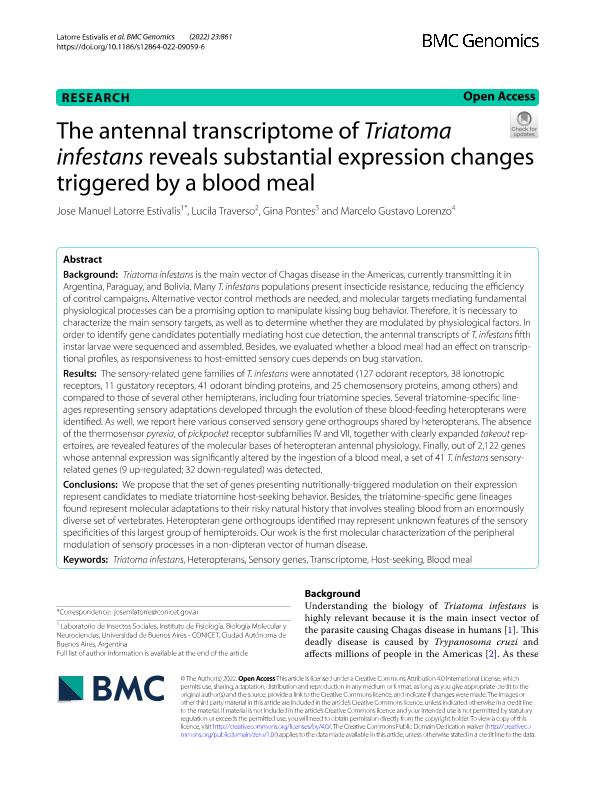Mostrar el registro sencillo del ítem
dc.contributor.author
Latorre Estivalis, Jose Manuel

dc.contributor.author
Traverso, Lucila María

dc.contributor.author
Pontes, Gina
dc.contributor.author
Lorenzo, Marcelo Gustavo

dc.date.available
2023-08-23T13:09:28Z
dc.date.issued
2022-12
dc.identifier.citation
Latorre Estivalis, Jose Manuel; Traverso, Lucila María; Pontes, Gina; Lorenzo, Marcelo Gustavo; The antennal transcriptome of Triatoma infestans reveals substantial expression changes triggered by a blood meal; BioMed Central; BMC Genomics; 23; 1; 12-2022; 1-21
dc.identifier.issn
1471-2164
dc.identifier.uri
http://hdl.handle.net/11336/209037
dc.description.abstract
Background: Triatoma infestans is the main vector of Chagas disease in the Americas, currently transmitting it in Argentina, Paraguay, and Bolivia. Many T. infestans populations present insecticide resistance, reducing the efficiency of control campaigns. Alternative vector control methods are needed, and molecular targets mediating fundamental physiological processes can be a promising option to manipulate kissing bug behavior. Therefore, it is necessary to characterize the main sensory targets, as well as to determine whether they are modulated by physiological factors. In order to identify gene candidates potentially mediating host cue detection, the antennal transcripts of T. infestans fifth instar larvae were sequenced and assembled. Besides, we evaluated whether a blood meal had an effect on transcriptional profiles, as responsiveness to host-emitted sensory cues depends on bug starvation. Results: The sensory-related gene families of T. infestans were annotated (127 odorant receptors, 38 ionotropic receptors, 11 gustatory receptors, 41 odorant binding proteins, and 25 chemosensory proteins, among others) and compared to those of several other hemipterans, including four triatomine species. Several triatomine-specific lineages representing sensory adaptations developed through the evolution of these blood-feeding heteropterans were identified. As well, we report here various conserved sensory gene orthogroups shared by heteropterans. The absence of the thermosensor pyrexia, of pickpocket receptor subfamilies IV and VII, together with clearly expanded takeout repertoires, are revealed features of the molecular bases of heteropteran antennal physiology. Finally, out of 2,122 genes whose antennal expression was significantly altered by the ingestion of a blood meal, a set of 41 T. infestans sensory-related genes (9 up-regulated; 32 down-regulated) was detected. Conclusions: We propose that the set of genes presenting nutritionally-triggered modulation on their expression represent candidates to mediate triatomine host-seeking behavior. Besides, the triatomine-specific gene lineages found represent molecular adaptations to their risky natural history that involves stealing blood from an enormously diverse set of vertebrates. Heteropteran gene orthogroups identified may represent unknown features of the sensory specificities of this largest group of hemipteroids. Our work is the first molecular characterization of the peripheral modulation of sensory processes in a non-dipteran vector of human disease.
dc.format
application/pdf
dc.language.iso
eng
dc.publisher
BioMed Central

dc.rights
info:eu-repo/semantics/openAccess
dc.rights.uri
https://creativecommons.org/licenses/by/2.5/ar/
dc.subject
BLOOD MEAL
dc.subject
HETEROPTERANS
dc.subject
HOST-SEEKING
dc.subject
SENSORY GENES
dc.subject
TRANSCRIPTOME
dc.subject
TRIATOMA INFESTANS
dc.subject.classification
Zoología, Ornitología, Entomología, Etología

dc.subject.classification
Ciencias Biológicas

dc.subject.classification
CIENCIAS NATURALES Y EXACTAS

dc.title
The antennal transcriptome of Triatoma infestans reveals substantial expression changes triggered by a blood meal
dc.type
info:eu-repo/semantics/article
dc.type
info:ar-repo/semantics/artículo
dc.type
info:eu-repo/semantics/publishedVersion
dc.date.updated
2023-06-30T10:36:15Z
dc.journal.volume
23
dc.journal.number
1
dc.journal.pagination
1-21
dc.journal.pais
Reino Unido

dc.journal.ciudad
Londres
dc.description.fil
Fil: Latorre Estivalis, Jose Manuel. Consejo Nacional de Investigaciones Científicas y Técnicas. Oficina de Coordinación Administrativa Ciudad Universitaria. Instituto de Fisiología, Biología Molecular y Neurociencias. Universidad de Buenos Aires. Facultad de Ciencias Exactas y Naturales. Instituto de Fisiología, Biología Molecular y Neurociencias; Argentina
dc.description.fil
Fil: Traverso, Lucila María. Consejo Nacional de Investigaciones Científicas y Técnicas. Centro Científico Tecnológico Conicet - La Plata. Centro de Endocrinología Experimental y Aplicada. Universidad Nacional de La Plata. Facultad de Ciencias Médicas. Centro de Endocrinología Experimental y Aplicada; Argentina
dc.description.fil
Fil: Pontes, Gina. Consejo Nacional de Investigaciones Científicas y Técnicas. Oficina de Coordinación Administrativa Ciudad Universitaria. Instituto de Biodiversidad y Biología Experimental y Aplicada. Universidad de Buenos Aires. Facultad de Ciencias Exactas y Naturales. Instituto de Biodiversidad y Biología Experimental y Aplicada; Argentina
dc.description.fil
Fil: Lorenzo, Marcelo Gustavo. Fundación Oswaldo Cruz; Brasil
dc.journal.title
BMC Genomics

dc.relation.alternativeid
info:eu-repo/semantics/altIdentifier/url/https://bmcgenomics.biomedcentral.com/articles/10.1186/s12864-022-09059-6
dc.relation.alternativeid
info:eu-repo/semantics/altIdentifier/doi/http://dx.doi.org/10.1186/s12864-022-09059-6
Archivos asociados
